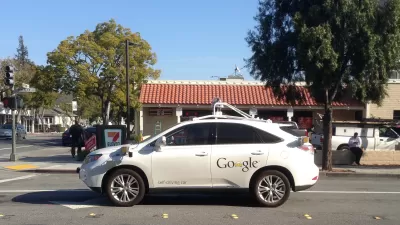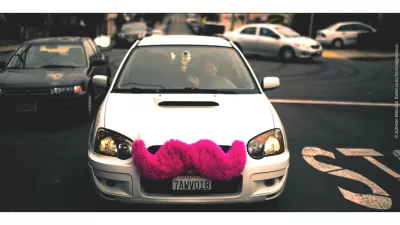As companies like Uber, Lyft, and Bridj expand to small scale transit options, they are setting the stage for a new kind of small scale transit oriented development where the new station is the sidewalk.

As far as billion-dollar companies go, if Walmart is the poster child of sprawl, could Uber be the new face of smart growth?
Uber, best known for its smartphone-based taxi service, is expanding rapidly with initiatives less about individual rides and more about mass mobility. So far, reactions to Uber’s plans for driverless vehicles, "smart routes," and shared rides seem pretty wary. Gizmodo’s Alissa Walker recently summarized concerns regarding equity, wages, and potential declines in public transit ridership.
While it is helpful to anticipate what can go wrong, it is even more important to get in front of trends to harness the benefits of tech-enabled mobility. Here is a short outline of what cities and suburbs need to do now to prepare for systems that are both public and private, driver and driverless, and solo and shared.
- Understand What is Unfolding: If regions sit back and do nothing, mobility companies will still go forward. Companies are already collaborating with any willing partner, whether it’s a university (Virginia Tech in the Washington D.C. region), states, or cities. So the real questions need to address how services like driverless vehicles roll out and how soon this will begin to unfold.
- Set the Big Picture: No, you don’t need to slog through a four-year-long visioning process, but cities need to set a vision and expectations related to equitable service, data sharing, and use of public assets and infrastructure up front. Cities need to envision the role each mode plays, including public transit like Metro, local buses like D.C.’s Circulator and Arlington, Virginia’s ART buses, active transportation, private cars, and future modes such as driverless transit.
- Set the Priority on Transit: For the most part, the bigger the vehicle, the higher the mobility performance. Sure, driverless cars reduce the room between vehicles and supposedly help the flow of traffic, but all those cars still need the value drain of parking. Cities need to make sure conversations on driverless cars are less about individual vehicles and more about optimizing the economic power of land use plus transportation.1
- Design New Nodes: This is the most important point for cities. Uber uses “smart routes” to suggest collection points for multiple riders, thus reducing the time needed to pick up disparate fares. As mobility companies grow and proliferate (Split, for instance, is a new ride share company in D.C.), the competition for convenient curbside collection points will be fierce. Arlington is known for perfecting transit-oriented development for heavy transit. Now there’s an opportunity to invent a new kind of TOD for flexible transportation. Uber’s new moves to designate collection points underscore an important point: nodes and access to those nodes matter.
This is also important because areas of town not considered transit oriented now become more attractive. Areas with some density, mixed uses, and pedestrian amenities form new nodes where travelers don’t come to transit, transit comes to travelers.
- Rethink Infrastructure: If curbsides and new pickup "stations" in the public right of way become the hottest commodity in infrastructure, then cities need to figure out how to fairly appropriate and manage public property. Sure, taxis have picked up and discharged fares in the street for a long time. But as more travelers swap personal vehicles for hailed rides, we move the trip ends from parking spaces to streets and curbsides. This is not how we solve congestion.
- Data and Performance: In pre-thinking what could go wrong, cities need to establish performance benchmarks for equity, congestion management, and other pressures beyond transportation.
- Planning for Heavier Transit: The sharing economy (including rideshare and driverless cars) is all about taking advantage of existing unused assets like empty seats in vehicles or space on roadways. Think about it: Uber and Lyft are creating transit with no new infrastructure (with help from Waze to avoid congestion points). But at what point of roadway saturation do cities need to consider heavier transit? And what does that transit look like in cities and suburbs?
The disruption associated with Uber and Lyft is not confined to transportation. As these companies grow, their aggressive expansion plans are poised to send ripples throughout the entire municipal enterprise. Uber, perhaps unintentionally, has set off a new wave of urban planning. Are cities ready?
Photo by b k
FULL STORY: Uber’s New Wave of Urban Design. Are Cities Ready?

Pennsylvania Mall Conversion Bill Passes House
If passed, the bill would promote the adaptive reuse of defunct commercial buildings.

Coming Soon to Ohio: The Largest Agrivoltaic Farm in the US
The ambitious 6,000-acre project will combine an 800-watt solar farm with crop and livestock production.

World's Largest Wildlife Overpass In the Works in Los Angeles County
Caltrans will soon close half of the 101 Freeway in order to continue construction of the Wallis Annenberg Wildlife Crossing near Agoura Hills in Los Angeles County.

California Grid Runs on 100% Renewable Energy for Over 9 Hours
The state’s energy grid was entirely powered by clean energy for some portion of the day on 37 out of the last 45 days.

New Forecasting Tool Aims to Reduce Heat-Related Deaths
Two federal agencies launched a new, easy-to-use, color-coded heat warning system that combines meteorological and medical risk factors.

AI Traffic Management Comes to Dallas-Fort Worth
Several Texas cities are using an AI-powered platform called NoTraffic to help manage traffic signals to increase safety and improve traffic flow.
City of Costa Mesa
Licking County
Barrett Planning Group LLC
HUD's Office of Policy Development and Research
Mpact Transit + Community
HUD's Office of Policy Development and Research
Tufts University, Department of Urban and Environmental Policy & Planning
City of Universal City TX
ULI Northwest Arkansas
Urban Design for Planners 1: Software Tools
This six-course series explores essential urban design concepts using open source software and equips planners with the tools they need to participate fully in the urban design process.
Planning for Universal Design
Learn the tools for implementing Universal Design in planning regulations.



























